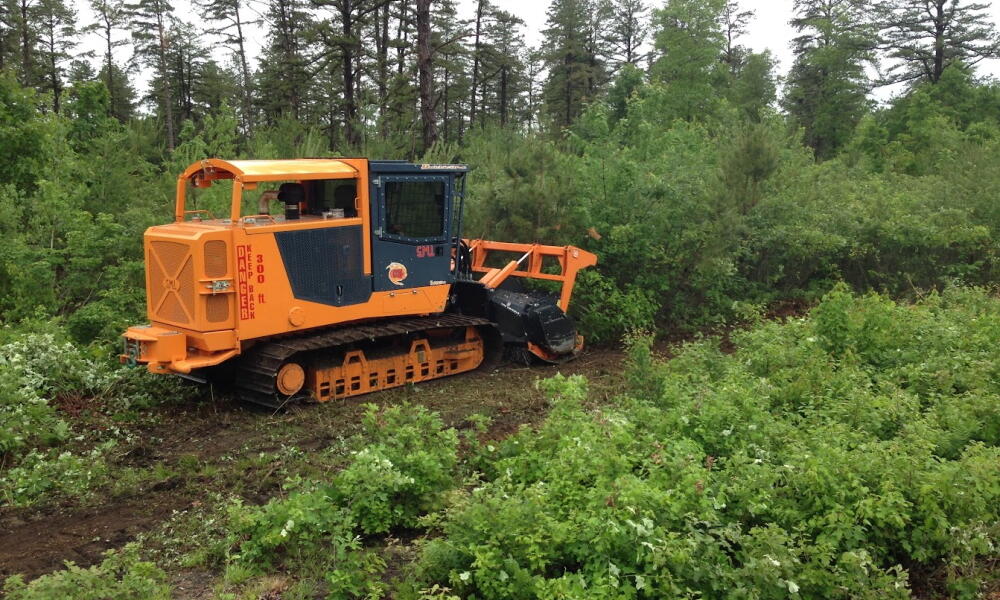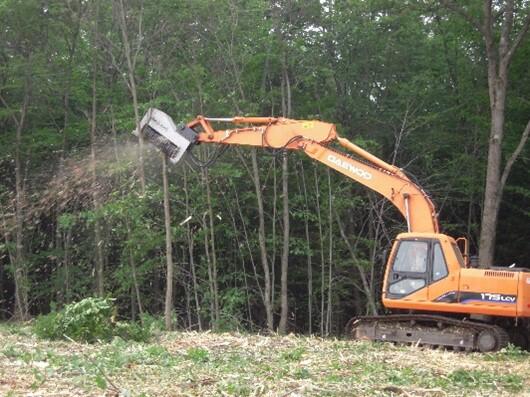Practice description
Grass mowing is the cutting of areas consisting of grass and/or flowering plants to prevent woody vegetation from establishing. Mowing and mulching is the mechanical treatment of small diameter trees and shrubs to reduce the canopy dominance and/or density of woody plant species. Fully or partially masticated woody biomass is typically left within the treatment area, and the size and arrangement of the retained material differs by method and may influence follow-up treatments. Mowing fields for the purpose of maintaining grassland bird habitat is described in the grassland bird management practice.
Goals and ecological processes
Preventing woody vegetation from establishing through grass mowing maintains grass and flowering plant species dominance and the associated characteristics provided by habitats that lack shrub and tree cover. It can be implemented in habitats where natural disturbances such as flooding and wildfire would prohibit shrubs and trees from establishing, or in areas where the goal is to prevent ecological processes that result in dominant plants consisting of shrubs or trees from advancing.
Reducing woody plant cover by mowing and mulching increases light, water, and other resources to plant species that make up the desired natural communities in the habitat types targeted by this practice. This practice can mimic natural disturbances like flooding, insect outbreak, beaver, wildfire, and larger wind events. These disturbances allow areas to reset back to an earlier, younger, and often more diverse stage of growth.
Target habitats and species
This practice is often used in abandoned wet meadows, agricultural lands, areas that have been previously logged, areas where the vegetative community’s vigor is reduced, often associated with dry, well-drained soils like barren ecosystems, meadows, grasslands, and woodland areas where a strong shrub or sapling response is desired, such as aspen, maple, or oak stump sprouting. This includes the following habitat types:
- Wet meadows (component of marshes and wet meadows)
- Cultural shrublands
- Cultural grasslands
- Young forests
- Barrens
- Dry grasslands and heathlands
- Oak forests and woodlands
Mowing and mulching benefits a wide range of species of greatest conservation need, including snakes, turtles, rabbits, pollinators, rare plants, and songbirds, as well as more common species like deer, bear, and turkeys.
Associated practices
Grass mowing may include occasional stems of small woody vegetation, and mostly involves periodic cutting of grasses, sedges, and other herbaceous plants, and it is a part of grassland bird management. Mowing and mulching are frequently part of efforts to restore forested habitats to shrub-dominated natural communities and habitat types. In this role, selective tree removal is often used to reduce the overstory tree canopy, removing some or all portions of the trees from the treatment area. Invasive plant control may be used to address any invasive exotic plants present, using chemical, manual, and mechanical removal for control of undesired vegetation species. Prescribed fire also controls competing vegetation selectively but does so through the differential responses of species to fire and the resulting changes in soil conditions and microclimate. Mowing and mulching is sometimes used as a short-term replacement for prescribed fire to maintain or reset shrubs at a site when operational considerations delay the use of prescribed fire.
Methods
Mowing and mulching includes many mechanical techniques, including grass mowing, drum mowing, “brush hogging”, and roller-chopping.
Practice details
The type of machinery to be used will depend on the vegetation present and the desired outcomes. Where habitat types require specific outcomes, they are described in the relevant habitat management recommendations.
- Grass mowing: Cutting of grass and flowering plants with a sickle bar, rotary, or similar mower, often pulled by a farm tractor or smaller machinery. These tools are suitable primarily for herbaceous vegetation.
- Drum mowing: Mulching in-place with drum-style mulching head attached to skid-steer or excavator platform, often referred to by product names such as Fecon, Bullhog, Dennis Cimaf mulchers, Brontosaurus. These tools are most often used when woody plants with larger-diameter stems are present and when the production of residual wood chips is acceptable.
- “Brush hogging”: Cutting and partial mulching in-place with rotary mowers that are special purpose or attached to tractors, skid-steers, and excavator platforms. Commonly referred to by product names such as Bush Hog, D.R., and Billy Goat. These tools can handle smaller-diameter woody stems and result in wood that is shredded rather than chipped.
- Roller-chopping: Partial cutting and mastication in-place by a weighted drum with metal protrusions, typically pulled behind a large 4WD tractor, bulldozer, or forestry skidder. This technique is useful for reducing the height of shrubs without producing chips or shredded material.
Planning
Scale and landscape context should be considered based upon requirements and appropriateness of target species and desired target habitat conditions, and technical assistance is recommended to help the landowners make the best-informed choice of management and scale. See the Management priorities and planning guide for more information.
Return intervals
Grass mowing will maintain areas of that consist of grasses and flowering plants and should generally occur a minimum of once every three years after the first fall frost to preserve nectar and pollen sources for insects. Rotational growing season mowing that leaves a significant portion of the available habitat intact during a given year may be necessary in some cases to achieve or maintain plant community composition objectives. Some native flowering plant species that are beneficial, such as goldenrods, can become dominant in and mowing during the growing season can reduce their presence maintaining a greater overall diversity of flowering plants. Rotationally mowing approximately one half of the area that consists of dominant plants can reduce their presence and allow other species to persist. In locations mapped as 'Priority Habitat' for state-listed turtles, grass mowing should occur outside the turtle active season and according to additional procedures in the MassWildlife Natural Heritage & Endangered Species Program Mowing Advisory Guidelines in Rare Turtle Habitat.
When mowing and mulching is being used to manage clumps of shrubs and young trees in cultural shrublands or as temporary substitution for prescribed fire, it should be implemented every 3–5 years before stems are 3 inches in diameter or are too large for available equipment to handle. Where ground-nesting or shrub-nesting birds are present, his should ideally be completed outside the bird nesting season or should be scheduled in such a way that only portions of the available habitat are managed in any given year, if the mowing is intended to improve or increase habitat for those species. In locations mapped as 'Priority Habitat' for state-listed turtles, grass mowing should occur outside the turtle active season and according to additional procedures in the MassWildlife Natural Heritage & Endangered Species Program Mowing Advisory Guidelines in Rare Turtle Habitat.
Mowing and mulching is also used during the restoration process in habitats such as dry woodlands and barrens or oak forests and woodlands to temporarily reduce understory shrub/sapling heights and to eliminate stems of seedlings and saplings of non-sprouting tree species such as eastern white pine. These uses are on a case-by-case basis, and details can be found in the relevant habitat management recommendations.
Additional resources
- Best Management Practices for the New England Cottontail: How to Create, Enhance, and Maintain Habitat
- Brown Forestry Products
- Connecticut’s Young Forest Habitat Initiative
- Mowing Advisory Guidelines in Rare Turtle Habitat
- New England Cottontail
- NRCS Habitat Program
- The Young Forest Project
- Timberdoodle: The Woodcock Management Plan
- Young Forest Guide

